Make Better Decisions with Search Analytics
Learning Objectives
After completing this unit, you’ll be able to:
- Install the Community Management Package for Communities with Chatter (if not installed yet).
- View and edit search reports in the site's Search Dashboard.
- Use search reports to create synonym groups.
- Use search reports to improve articles and discussions.
Install the Community Management Package
It's simple to set up the Community Search Dashboard—everything you need is part of an easy-to-install AppExchange package called the Spring ’21 Salesforce Community Management Package for Communities with Chatter.
If you haven't installed the AppExchange package in your site, follow one of these options:
- From the Workspaces home page, click Install AppExchange Package on the top banner. You are directed to the AppExchange where you can install the package. You'll get it up and running faster than you can say “triple half-caff latte with extra foam.” (Don’t worry, we can wait!)
- If you're using a Trailhead Playground with the Trailhead Playground Starter app:
- Select the Install a Package tab.
- In the Package ID field, enter:
04t1J000000OUuGQAWthen click Install.
If you're using an older playground or a Developer Edition org, you’ll need your username and password. This article shows you how to find your username and reset your password. If you have trouble installing a package or app from AppExchange, follow the steps in this article.
After you've installed the managed package, return to the Capricorn Cafe and select Experience Workspaces.
View Search Activity in the Community Search Dashboard
Every site is different—each one’s particular flavor depends on who is in it and what they’re interested in. You want to make sure your site is stocked with content that meets your members’ needs. Fortunately, you don’t need special powers to find out what’s on people’s minds. With the Community Search Dashboard, you can see exactly what your members are looking for.
The dashboard helps you answer questions, like:
- Which search terms are members searching for the most?
- Which search terms aren’t getting any results?
- What type of member is searching for a term?
With these questions answered, you can create content that gives site members answers to their questions.
To get to the Community Search Dashboard:
- Go to Experience Workspaces.
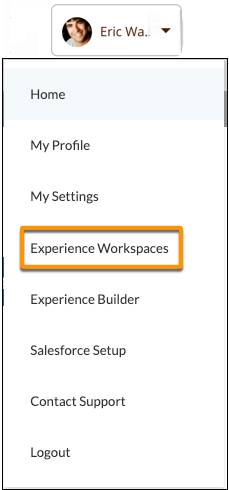
- Enter
All Sitesin the Quick Find box, then select Workspaces for the appropriate site.
- Click Dashboards.
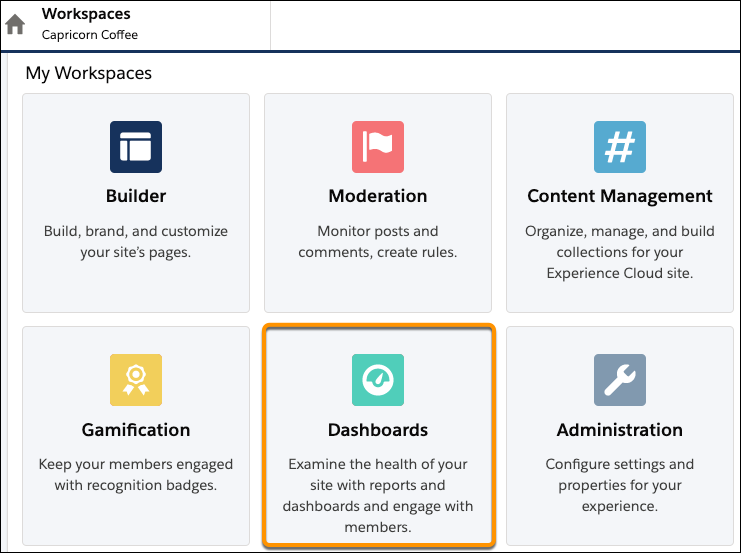
- To see the current dashboard, select the Dashboards tab then select Search.
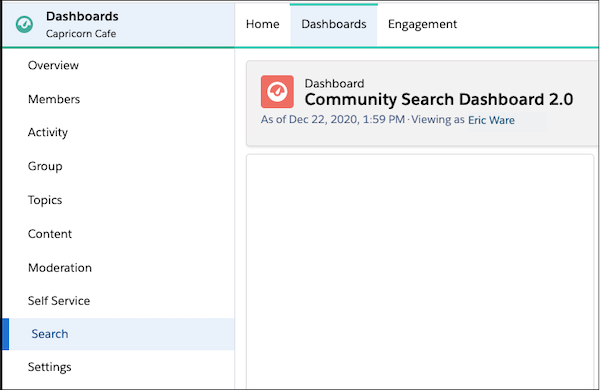
Edit Dashboards and Reports
You can edit the dashboards you see and the reports and their formats on each dashboard.
- To add and remove reports from the dashboard, go to Settings. In the row for the Search dashboard, select Community Search Dashboard 2.0. If you don’t see it in the list of available dashboards, download or upgrade to the latest Community Management package from AppExchange.
- To further modify how the search dashboard looks, click Edit Dashboard.
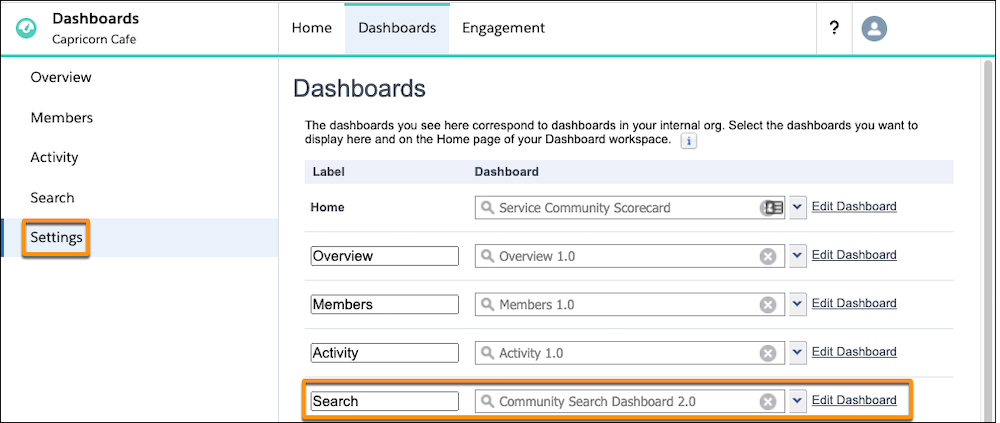 From the Edit Dashboard page, you can make many changes to how your dashboard looks:
From the Edit Dashboard page, you can make many changes to how your dashboard looks:
- To move reports, just click and drag them.
- To edit a report, select the wrench icon.
- To delete a report, click the X.
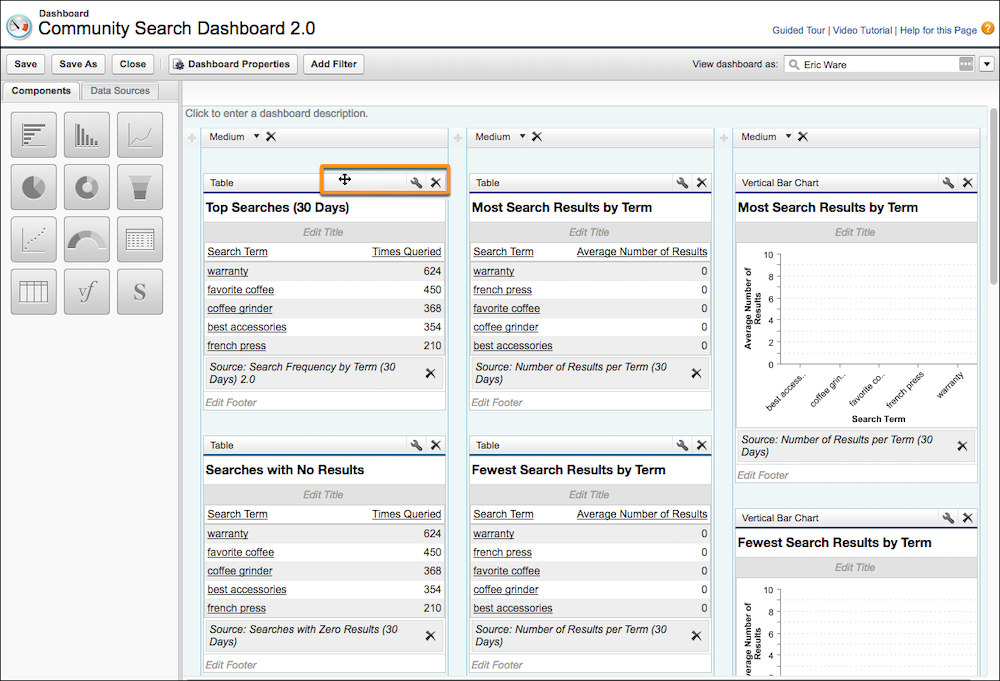
- To add a report, switch from the Components tab to the Data Sources tab. Expand Reports then select and expand the Communities Reports folder.
- To find the search reports, enter
searchorautocompletein the Quick Find box (1). Drag the report you want to add from the Reports column to the spot you want in the dashboard area (2).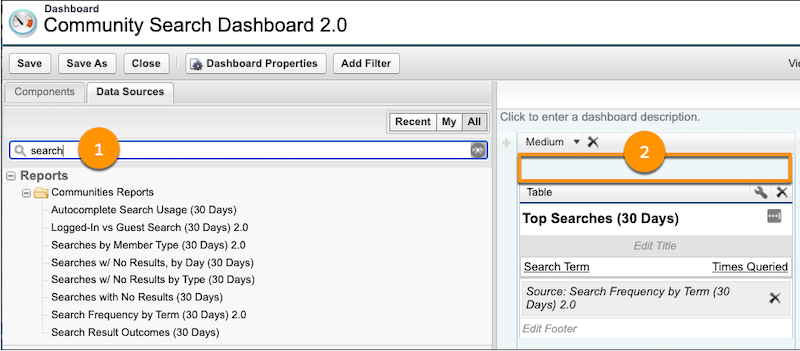
- Switch back to the Components tab, then drag a report type to your new report.
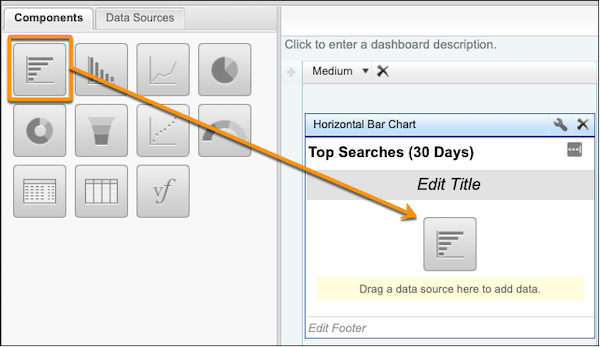
- You can then edit the title of the report by clicking Edit Title. To edit other report information, such as the Maximum Values Displayed or the sort order, click the wrench icon, make your changes, then click OK.
- When everything’s just the way you want, click Save, then Close.
Capricorn Coffee made sure to put three key reports at the top of its dashboard:
- Top Searches in the last 30 days
- Searches with No Results
- Fewest Search Results by Term
Top Searches (30 Days): What are site members searching for the most? This report tells you what’s most on their minds. In the last 30 days, the top searches in the Capricorn Cafe site are warranty, favorite coffee, coffee grinder, best accessories, and french press.
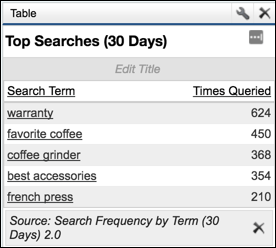
Searches with No Results: People searching for these terms in the site aren’t getting any results. Don’t worry, we’ve got ways to turn those frowns upside down.

Fewest Search Results by Term: People searching for these terms are getting only a few results.
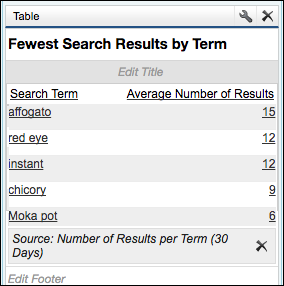
Some other reports to check out, and the questions they answer:
- Autocomplete Click-Through % (Last 30 Days): What percentage of autocomplete search results had a successful click?
- Autocomplete Search Usage (30 Days): Are users clicking suggested search results?
- Logged-In vs Guest Search (Last 30 Days): How many users are logged in when they enter a search term?
- Most Autocomplete Clicks (30 Days): Which search terms led to the most clicks of suggested search results?
- Number of Results Per Term (30 Days): How many search results are returned per search term?
- Searches by Member Type (Last 30 Days): What type of member is searching for a term?
- Search Result Outcomes (30 days): How many searches had results?
- Searches with No Results, by Day (30 Days): Which search terms had zero results on any given day?
- Searches with No Results by Type (30 Days): What type of member is searching for a term, and did it have results?
View the Dashboard
Now, let's return to the Dashboard Home tab and see what Capricorn Coffee’s dashboard looks like. The four tables show lists of top searches, search terms that are getting no results, search terms that are getting the most results, and search terms that are getting few results. The last two reports are also represented as bar graphs.
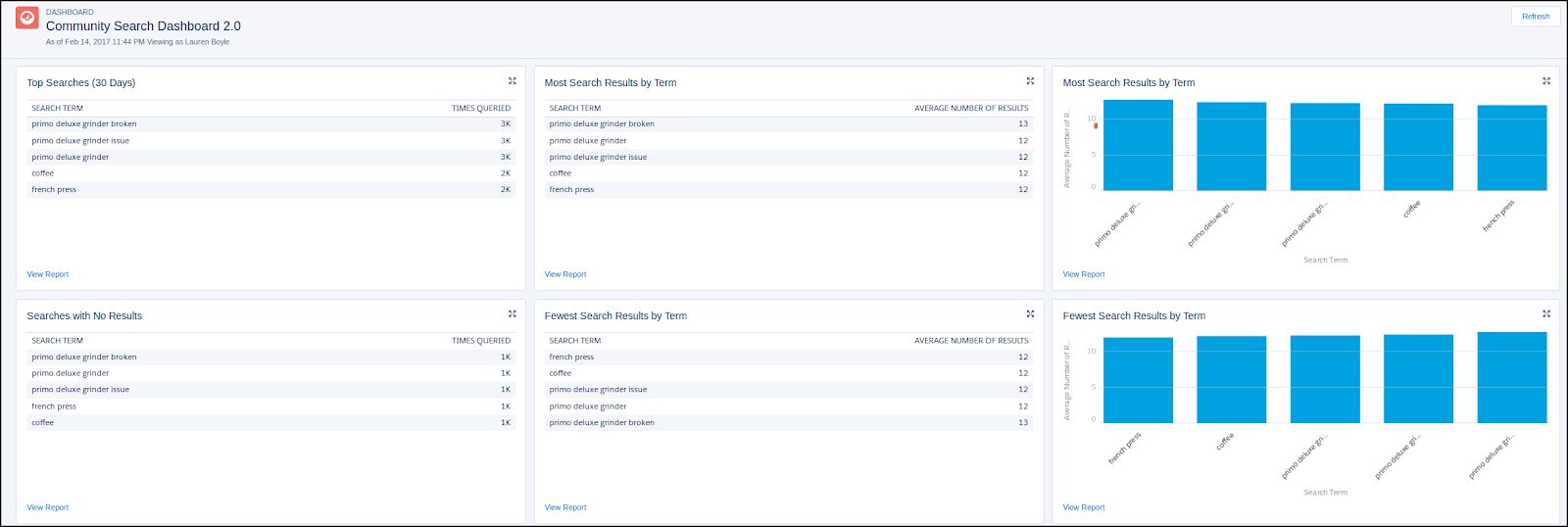
If you have a Google Analytics account, you can get access to even more search data. For example, you can see what people click after they search, and where people were in your site when they decided to create a support case. For more information, see this article about the Google Analytics™ Search Activity Dashboard.
Use Reports to Create and Improve Synonym Groups
Check out the list of top search terms. Are any of them related? For example, Capricorn noticed that its list of top search terms included foam and froth.
Capricorn also looked at the search terms not getting results and noticed air bubbles on the list. So Capricorn’s Salesforce admin created a synonym group that included all of those words. Now, members searching for air bubbles are getting results!
An org can create up to 10,000 synonym groups, so get out your thesaurus, order a triple espresso, and have a party!
Use Reports to Improve Articles and Discussions
Capricorn Coffee also noticed that a lot of customers were looking for information about making their own cold brew coffees at home. Although Capricorn’s cafes helped fuel the cold brew trend, its site was a little light on the kinds of detailed articles that people were looking for.
Not wanting to fall behind the curve, Capricorn had one of its best baristas write an article that thoroughly geeked out about cold-brewing techniques. The barista also started a related discussion thread, so other site members could ask questions and share techniques.
The barista’s article was so popular, in fact, that he became a regular contributor to the site, and the Capricorn Cafe he worked at increased its sales by 20%.
Use Reports to Celebrate Your Successes
After you’ve scrutinized all the search data and started thinking about some action items, step back for a moment. What these numbers show you is that your members are engaged—with your products, with your company, with your ideas.
Now that you’ve learned how optimizing search can make your site even better, you’ve taken a big step toward making sure your site continues to grow and thrive.
Before you get back to the grind, take a moment to bask in your accomplishment—you deserve it!
Resources